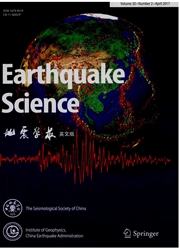

 中文摘要:
中文摘要:
We continuously monitor the long-term seismic velocity variation of one of the major ruptured faults of the devastating 2008 Mw7.9 Wenchuan earthquake in China from July 2009 to January 2012,jointly using accurately controlled routinely operated signal system active source and seismic noise-based monitoring technique.Our measurements show that the temporal velocity change is not homogeneous and highly localized in the damaged fault zone and the adjacent areas.Velocity variations from the active and passive methods are quite consistent,which both are characterized by ±0.2 % seasonal variation,with peak and trough at winter and summer,respectively.The periodic velocity variation within fault zone exhibits remarkably positive correlation with barometric pressure with stress sensitivity in the order of 10-6Pa-1,suggesting that the plausible mechanism might be the crack density variation of the shallow subsurface medium of the damaged fault zone in response to the cyclic barometric pressure loading.
 英文摘要:
英文摘要:
We continuously monitor the long-term seismic velocity variation of one of the major ruptured faults of the devastating 2008 Mw7.9 Wenchuan earthquake in China from July 2009 to January 2012,jointly using accurately controlled routinely operated signal system active source and seismic noise-based monitoring technique.Our measurements show that the temporal velocity change is not homogeneous and highly localized in the damaged fault zone and the adjacent areas.Velocity variations from the active and passive methods are quite consistent,which both are characterized by ±0.2 % seasonal variation,with peak and trough at winter and summer,respectively.The periodic velocity variation within fault zone exhibits remarkably positive correlation with barometric pressure with stress sensitivity in the order of 10-6Pa-1,suggesting that the plausible mechanism might be the crack density variation of the shallow subsurface medium of the damaged fault zone in response to the cyclic barometric pressure loading.
 同期刊论文项目
同期刊论文项目
 同项目期刊论文
同项目期刊论文
 Transfer functions of the well-aquifer systems response to atmospheric loading and Earth tide from l
Transfer functions of the well-aquifer systems response to atmospheric loading and Earth tide from l Influencing factors of seismic signals generated by un-tuned large volume airgun array in al and res
Influencing factors of seismic signals generated by un-tuned large volume airgun array in al and res Semiannual velocity variations around the 2008 M w 7.9 Wenchuan Earthquake fault zone revealed by am
Semiannual velocity variations around the 2008 M w 7.9 Wenchuan Earthquake fault zone revealed by am 期刊信息
期刊信息
